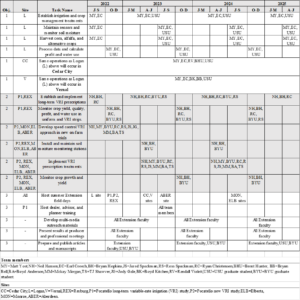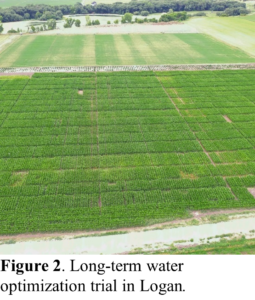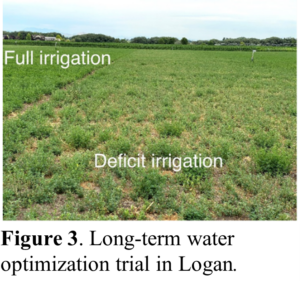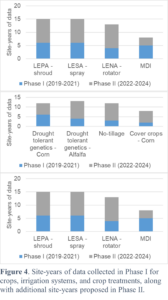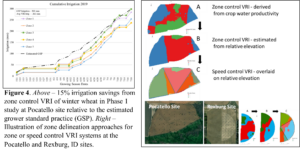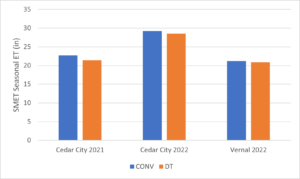Progress report for SW22-941
Project Information
Concerns about water scarcity are mounting due to rapid urban growth, depleting groundwater supplies, and drought resulting from reduced and variable snowpack in the western United States. The mega drought of 2020-2021 compounded this problem for most of this region. Several areas of Idaho and Utah have frequent water shortages and droughts that cause about $95 million per year of loss. We propose Phase II of a long-term water optimization study to answer these two critical research questions: (1) Which combinations of irrigation and crop management practices result in optimal crop yield, crop profit, and water use efficiency? and (2) How can variable-rate irrigation become operational on production farms?
To address these research questions, we propose sustaining and expanding ongoing work to: i) conduct long-term experiments to identify how individual and ‘stacked’ water conservation practices (irrigation, crop genetics, and crop management) optimize water use and increase crop profit at three water optimization trials in Utah (Logan, Cedar City, and Vernal), and ii) continue long-term zone variable rate irrigation (VRI) research in Pocatello and Rexburg, Idaho and conduct four new on-farm trials in Idaho and Utah (Pocatello, Aberdeen, Elberta, and Richfield) to test and develop speed-control VRI. Results from these efforts will be the basis for an aggressive outreach and training effort reaching irrigators, irrigation suppliers, crop advisors, and conservation planners to improve knowledge and adoption of water optimization best practices. Dynamic outreach components will include interactive field days at the research sites, presentations and publications through Idaho and Utah Extension and professional associations, and a training event for irrigation advisors.
The anticipated project outcomes in the Western Region include:
- Over 300 stakeholders will engage in discussions and demonstrations of water conservation research at eight field days;
- Over 1,000 stakeholders will be educated on practices to optimize their water use during various Extension and professional presentations;
- Producers, agricultural professionals, and others will have access to timely information about practices that optimize water use through various Extension, farm press, and professional publications.
Producing and disseminating results on the suites of practices that economically and feasibly optimize water has and should continue to lead to greater acceptance and use of these practices. Results from Phase I of this work have shown that some combinations reduce irrigation use without impacting yield. We estimate that annual diversion of water could be reduced by 100,000’s of acre-feet if advanced practices were implemented by just half of the irrigators in Idaho and Utah. These outcomes would also assist producers and other stakeholders involved in proposing, creating, and administering cost-share or water bank programs to help optimize water use. Furthermore, we expect these trials will leverage the large foundation we have built during the last three years in Phase I of this project and provide valuable information concerning ideal short- and long-term water optimization strategies. This work has and should continue to spur further funding and support from the state and federal agencies where water conservation and optimization is a high priority.
- Identify combinations of six water conservation practices (irrigation system and rate, coupled with crop type, crop genetics, cover crops, and tillage) with the greatest ability to optimize crop production, crop profit, and water use. Years 1-3.
- Demonstrate variable-rate irrigation systems that improve water and energy use efficiencies in long-term trials and on production farms. Years 1-3.
- Deliver dynamic educational products and training on water optimization through Extension and coordinated outreach to increase awareness and adoption of proven water optimization practices. Years 1-3.
Cooperators
- - Producer
- - Producer
- - Producer
- - Technical Advisor
- - Producer
- - Technical Advisor
- - Producer
- - Producer
- - Technical Advisor
- - Technical Advisor
- - Technical Advisor
Research
Our first two objectives focus on research and are presented here. The third objective centers on education efforts and will be discussed in the education plan section.
Objective 1: Identify combinations of six water conservation practices with the greatest ability to optimize crop production, crop profit, and water use.
Three long-term water optimization trials were established in Utah in Phase I of this project. The first was established in Logan in 2019, the second in Vernal in 2019, and the third in Cedar City in 2021. At each site, a new linear move sprinkler (“lateral”) was installed with funding and support from several federal, state, and local partners. These stakeholders have invested in the infrastructure and Phase I helped establish the trials, while Phase II is critical to take advantage of the investments.
The treatments at each of the three sites include three replications of:
- four irrigation systems [the conventional mid-elevation spray application (MESA) system vs. low-elevation spray application (LESA), low energy precision application (LEPA), and mobile drip irrigation (MDI)];
- four irrigation rates (50, 50, 75, and 100% of evapotranspiration). One of the 50% irrigation rates is a partial irrigation strategy focused on applying more water during critical crop growth stages; and
- up to five crop management treatments depending on the crop:
- Corn has five treatments (conventional, drought-tolerant genetics, no-tillage, cover crops, and a fifth treatment that combines the latter three conservation practices)
- Alfalfa has two treatments (conventional vs. drought tolerant genetics)
- Small grain forage has two treatments (tillage vs. no-tillage)
- Alternative crops (teff, sorghum-sudangrass, and Italian ryegrass) do not have crop treatments but are tested against other traditional crops
The sixteen irrigation treatments (four systems x four rates) are arranged along each lateral (Fig. 2). Each span (150-180 ft long) has a different irrigation system with a random placement of the irrigation rates in four equally sized quarters. The rate differences were achieved by modifying sprinkler nozzles in each quarter. Crop management treatments were arranged perpendicular to the direction of the irrigation system to create replicated combinations of all crop management and irrigation system combinations.
At each site, one block of about six acres is utilized for alfalfa. Three random strips perpendicular to the lateral were planted to a conventional alfalfa variety and another three were planted to a drought-tolerant alfalfa variety (Ladak II). Alfalfa yield has and will be measured in 96 plots at each location (16 irrigation treatments x 2 varieties x 3 replicate strips; Fig. 3) for each alfalfa cutting utilizing research or commercial harvesters. Another 6-acre block is used for a corn-corn-small grain forage crop rotation. This area has 256 small plots (20 x 30 ft) that includes three replications of the 16 irrigation treatments and five crop treatments. Corn is planted parallel to the lateral so sprinklers can irrigate and move between and not across corn rows. Corn silage yield has and will be measured each year in all plots using a two-row Gehl corn chopper with a pull-behind weigh wagon. Small grain forage yield is measured using the same methods as alfalfa. Finally, a 2-acre block is reserved for alternative crops at each site. This allows for three replicated strips each of two alternative crops. The two crops are rotated annually and have included safflower, teff, triticale, and sorghum-sudangrass in Phase I. Alternative crops have and will be harvested with research harvesters.
Forage quality will be estimated on all crops using near infrared reflectance spectroscopy (NIRS) and standardized calibrations. Forage quality parameters differ by crop but all parameters that influence crop selling price will be measured to allow profit calculation.
In order to measure water use efficiency, we will measure irrigation rates using flow meters that were installed on each lateral. We will also continue to monitor hourly soil moisture content at 40 plots at each site. In each plot, water content sensors are installed to three depths (6, 18, and 30 inches). The plots include eight of the irrigation treatments (4 systems x 2 irrigation rates – 50 and 100% evapotranspiration) in all three crops as well two of the crop treatments for alfalfa (conventional vs. drought-tolerant) and two for corn/small grains (conventional vs. the combined no-tillage, drought-tolerant genetics, and cover crops).
Phase I allowed us to install all the irrigation systems and soil moisture sensors, and to establish all the crop treatments. We were able to collect data mostly on corn because it is an annual crop and could be established rapidly (Fig. 4). Alfalfa, a perennial, and the most dominant crop on western farmland, took several years to establish. We trained two graduate students who have published preliminary data on early impacts of irrigation systems and deficit irrigation on corn, establishing alfalfa, and alternative crops.
In Phase II, we will examine how water optimization practices influence established alfalfa. We will also gather additional and needed data for two existing alternative crops (teff, sorghum-sudangrass) and two new alternative crops (triticale and Italian ryegrass) that were highly recommended by local producers and crop advisors. The production, profit, and water use of these crops will be compared to alfalfa and corn. Our database of irrigation system evaluations will also grow, and we will expand examination of a new irrigation system [low-elevation rotator sprinkler (LENA)] in place of MDI at Cedar City. We will replace MDI because it has been extremely problematic in terms of water quality and repairs. Furthermore, now that our no-tillage and cover crop treatments have been in place for one to three seasons, we can begin to more adequately examine how they influence crop production and water use.
In summary, Phase II will include conducting the three water optimization trials at Logan, Vernal, and Cedar City for the 2022-2024 seasons following methods and procedures discussed above and vetted in Phase I. We will have at least 5-13 site-years of data on all the alternative crops, alfalfa, and corn. We will also have 8-13 site-years of comparisons of irrigation systems and crop treatments (no-tillage, drought-tolerant genetics, and cover crops). This additional data will greatly strengthen our results and demonstrate the crop production and water use impacts of water optimization techniques for major crops of the West.
Objective 2: Demonstrate variable-rate irrigation systems that improve water and energy use efficiencies.
Variable-rate irrigation (VRI) utilizes site information and irrigation technology to apply spatially variable irrigation rates that match site-specific growing conditions. VRI aims to improve energy and water use efficiency by avoiding areas of over- or under-irrigation. Two types of VRI are zone control and speed control. Phase I of this project developed and tested a zone control VRI system at two Idaho study locations (Pocatello and Rexburg). Zone control VRI allows differing irrigation rates for zones of any shape by regulating individual sprinklers. The zone control VRI system we developed in Phase I consists of:
- defining irrigation zones,
- characterizing soil water holding properties by zone using sensors,
- real-time, zone specific tracking of soil water depletion, and
- VRI recommendations that maintain soil water within a target depletion range.
We documented a 15% irrigation water savings and similar total yield compared to the grower’s standard practice (Fig. 5). Other research has documented similar advantages of VRI (Sadler et al., 2002; Hedley and Yule, 2009; West and Kovacs, 2017).
Interest in VRI is increasing in southern Idaho because of recent water rights adjudications that allowed producers with zone control VRI to develop new irrigated land area equal to the unfarmed, un-irrigated rock outcroppings common in this area. However, adoption rates of zone control VRI are expected to proceed slowly. During Phase I, feedback from stakeholders indicated that VRI could be applied more extensively if approaches were simplified and developed for speed control VRI. Speed control VRI is limited to wedge-shaped zones created by changing the travel speed of pivots. Although less flexible, this approach can be implemented on nearly all existing pivots with minimal investment, while still gaining some of the water conservation advantages of zone control.
Long-term zone VRI trials
In Phase II of this project, we will continue to monitor and demonstrate zone VRI practices in 2022- 2024 at the long-term field sites in Pocatello and Rexburg, Idaho. Phase I allowed us to collect data mainly on wheat production. In Phase II, we will be able to assess the impacts of zone VRI on potato production in Pocatello (wheat in 2022-2023 and potato in 2024) and alfalfa production in Rexburg. At both sites, we will continue to test uniform irrigation zones vs. VRI to determine how zone VRI impacts crop yield, quality, profit, and water use. We anticipate that the advantages of VRI will be most pronounced in potato due to its high value but should also offer many advantages in alfalfa due to its high water use.
New speed control VRI on-farm trials
We propose additional on-farm trials that modify our VRI system for a simplified, speed control application that captures advantages similar to those of zone control VRI but are more easily adopted by producers. In Phase I, we used intensive soil sampling throughout the growing season under uniform irrigation to estimate crop water use to define VRI zones. This information was coupled with yield to estimate spatial variation of crop water productivity and to delineate precise zone control VRI zones. We then tested how well simple variables [electrical conductivity (ECa), slope, relative elevation, yield] could predict VRI zones. VRI zones predicted from relative field elevation most closely matched those derived from crop water productivity. In Phase II of this project, we will evaluate yield and water savings with speed control VRI zones delineated using relative field elevation at four new farm fields. This will include two sites in Idaho (Aberdeen and Pocatello) and two in Utah (Monroe and Elberta). At the Pocatello location, we will expand from one field location to include an additional speed control VRI field, with farm operations led by our producer representative, Ryan Christensen. The other three sites will be new collaborations with the producers that provided letters of commitment.
The four new speed-control VRI on-farm trials will be conducted for two growing seasons (2023-2024) with wheat or barley. We will develop and test speed control VRI prescriptions by dividing each field into eight large sectors. Four of the sectors will be four replications of uniform irrigation and the other four will have speed-control VRI. There will be four major steps to establishing sector-VRI prescriptions:
- Define VRI zones. We will work with cooperating producers to select one of their fields with variation in water need. Producers will share any prior yield maps from their field and we will collect digital elevation maps and soil ECa using a direct contact system (Veris V3150). These datasets will be paired to provide a starting point for a speed-control VRI prescription.
- Characterizing average soil water holding properties of soils. In Phase I, we documented that soil water retention properties (e.g., volumetric water content at field capacity, -10 kPa) varied among VRI zones within a field. In Phase II, we will install pairs of volumetric water content sensors (Meter, Teros 12) and soil water potential sensors (Meter, Teros 21) in each VRI zone. Paired sensors will allow us to determine zone specific, volumetric water content at irrigation upper and lower thresholds.
- Real-time, zone specific tracking of soil water depletion. The paired sensors in each VRI zone will be used to determine soil water depletion by comparing current volumetric water content values to the zone specific upper irrigation thresholds. We will monitor sensors in near-real time with remote access to the Meter Zentra Cloud system.
- VRI recommendations that maintain soil water within a target depletion range. Real-time, zone specific soil water depletions will be used to calculate VRI rates for every irrigation. The timing and rates of irrigation will be calculated to maintain soil water potential values between -10 kPa and -200 kPa. Soil data will be collected remotely each week through telemetry and prescriptions will be developed and shared with cooperating producers for implementation. This can be easily accomplished working with pivot manufacturer software such as FieldNet® as we have done in the past.
At the end of each growing season, we will work with cooperating producers to obtain a grain yield map of the entire field and the water use as recorded by their pivot software. We will also collect crop quality samples from each of the eight sectors prior to or at harvest by hand sampling. These data will be combined to assess how speed-control VRI impacts crop yield, quality, and profit, along with water use efficiency.
Objective 1 - Identify combinations of six water conservation practices (irrigation system and rate, coupled with crop type, crop genetics, cover crops, and tillage) with the greatest ability to optimize crop production, crop profit, and water use.
The ongoing water optimization or stacking conservation practice trial was conducted at Cedar City, Logan, and Vernal, Utah during the 2022 and 2023 seasons. The treatments at each of the three sites include three replications of:
- four irrigation systems [the conventional mid-elevation spray application (MESA) system vs. low-elevation spray application (LESA), low energy precision application (LEPA), and low-elevation Nelson advantage (LENA)];
- four irrigation rates (50, 50, 75, and 100% of evapotranspiration). One of the 50% irrigation rates is a partial irrigation strategy focused on applying more water during critical crop growth stages; and
- up to five crop management treatments depending on the crop:
- Corn has five treatments (conventional, drought-tolerant genetics, no-tillage, cover crops, and a fifth treatment that combines the latter three conservation practices)
- Alfalfa has two treatments (conventional vs. drought tolerant cultivar)
- Small grain forage has two treatments (tillage vs. no-tillage)
- Alternative crops (teff, sorghum-sudangrass, and Italian ryegrass) do not have crop treatments but are tested against other traditional crops
Major activities and progress:
The first major activity was to fully establish and maintain the three long-term irrigation sites near Logan, Vernal, and Cedar City Utah. It included removing mobile drip irrigation at the Vernal, UT site in 2022 and replacing it with LENA (based on cooperating farmer and stakeholder input and difficulty with filtration) and fully establishing the Cedar City site with all irrigation technologies and soil moisture sensors at the end of 2021.
A second major activity was to maintain a large soil moisture monitoring network at all three sites and use the data to calculate evapotranspiration (ET) of each treatment with a sensor installed. We used a soil moisture ET model (SMET) developed recently at Utah State University to estimate ET for plots with soil moisture sensors. The model requires daily soil moisture. Some of the soil moisture sensors were damaged by rodents or temporarily malfunctioned but we were able to collect data for several site-years for each crop. Preliminary results from alfalfa show that irrigation technologies and drought-tolerant alfalfa can sometimes reduce alfalfa ET, and deficit irrigation almost always decreases ET (Figure 1-3) – usually at the expense of alfalfa yield.
A third major activity was to hire and train graduate students. Dakota Boren completed his Master’s degree in 2022, Tina Sullivan is finishing her PhD this month, and a third Master’s student (Kamal Deep) has been recruited to maintain the trials in 2023-2024.
A fourth major activity was that was accomplished including collecting yield, forage quality, and water use data from each of the >1,500 research plot in 2023 and 2024 and publishing and presenting the results. These results are still in progress and summaries will be available soon. We have built a database to store all yield and forage quality data collected since 2019 when the study began. This database will be the basis of analyses for long-term trends.
A fifth was to collect additional data on existing and new alternative crops. In 2022 and 2023, we collected data for two existing alternative crops (teff, sorghum-sudangrass) and two new alternative crops (triticale and Italian ryegrass) that were highly recommended by local producers and crop advisors. The production, profit, and water use of these crops is in the process of being compared to alfalfa and corn.
A sixth major activity was to summarize data on how longer-term no-tillage and cover crop use (3-4 years) influence crop production and water use. We are in the process of summarizing this data across 2020-2023 to evaluate how silage corn production was impacted.
Objective 2 - Demonstrate variable-rate irrigation systems that improve water and energy use efficiencies in long-term trials and on production farms.
Variable irrigation research was conducted during the 2023 field season at five irrigated field locations in Utah or Idaho (Table 1). Each location also had a unique crop. At two field locations, the study evaluated speed control VRI, at two other locations the study evaluated zone control VRI, and one site was a VRI pilot study that evaluated spatial variation within the field under uniform irrigation. At all field sites, soil water content and water potential sensors were installed in multiple locations within the fields. As an example research layout for one of the field locations, speed-control VRI was evaluated at the Enterprise, UT site (Figure 4). At this site, the full, 120 ac pivot field was subdivided into four quadrants (SW, 40 ac; NW 40, 40 ac; NE, 20 ac; SE, 20 ac), with spatial variation of soil texture being the key factor delineating the quadrants on the west and east sides. The soil textural classes were sandy loams on the west side quadrants (SW, NW) and silty or silty clay loams on the east side quadrants (NE, SE). The quadrants were further divided by irrigation treatment with speed control VRI treatments paired within similar soil textural classes with a standard irrigation practice treatment as a control. Irrigation rates and timings for the standard irrigation practices were done as the normal practice by the farm cooperator. For the speed control VRI treatments, irrigation timing matched the standard irrigation practice, but rates were determined from the soil moisture sensors. The procedure for determining irrigation rates was first to determine site-specific soil water thresholds (volumetric water content at field capacity) for each VRI zone, then to compare volumetric water content measured with sensors at three depths with the thresholds and to calculate the irrigation rates needed for each VRI zone to bring the soil to the threshold.
Table 1. Variable rate irrigation studies conducted during the 2023 growing season
|
Crop |
Location |
Farm Cooperator |
Description |
|
Alfalfa |
Enterprise, UT |
Tanner Holt |
Speed control-VRI; Full center-pivot sprinkler divided into 4 quadrants |
|
Winter wheat |
Elberta, UT |
Boyd Anderson |
Speed control-VRI; Full center-pivot sprinkler divided into 4 quadrants |
|
Barley |
Grace, ID |
Ryan Christensen |
Zone control-VRI; Half pivot divided into three zones |
|
Potato |
Grace, ID |
Ryan Christensen |
Zone control-VRI; Half pivot divided into three zones |
|
Canola Seed |
Pingree, ID |
T.J. Shaver |
Assessing variability under uniform irrigation; Full pivot |
|
|
|
|
|
There were a total of 38 irrigation events during 2023 and there were four alfalfa harvests. Total amounts of irrigation applied for each quadrant varied by harvest interval and between the standard irrigation and speed control VRI treatments (Table x). On average, the speed-control VRI practice resulted in more than a 10 inch reduction in applied irrigation compared to the standard irrigation practice. Despite the differences in applied irrigation, there were no differences observed in alfalfa yield (Table 2).
Table 2. Rates of irrigation applied to alfalfa by irrigation treatment in 2023 at the Enterprise, Utah research location. Applied irrigation is shown by harvest interval or prior to greenup (Jan 01-Mar 31) or after the final harvest in 2023 (Sept 21-Dec 31).
|
Applied Irrigation (in) |
|||||||
|
|
Standard Irrigation Practice SW |
Speed Control VRI NW |
Standard Irrigation Practice NE |
Speed Control VRI SE |
Standard Irrigation Practice Average |
Speed Control VRI Average |
|
|
Jan 01-Mar 31 |
1.0 |
1.0 |
1.0 |
1.0 |
1.0 |
1.0 |
|
|
Harvest 1 Harvest 2 Harvest 3 Harvest 4 |
6.3 |
4.9 |
5.8 |
4.7 |
6.1 |
4.8 |
|
|
13.3 |
8.8 |
14.5 |
11.0 |
13.9 |
9.9 |
||
|
10.0 |
7.0 |
10.0 |
7.3 |
10.0 |
7.2 |
||
|
12.5 |
6.5 |
13.5 |
8.3 |
13.0 |
7.4 |
||
|
Sep 21-Dec 31 |
1.8 |
1.8 |
1.8 |
1.8 |
1.8 |
1.8 |
|
|
Total |
42.7 |
30.8 |
42.2 |
32.8 |
42.5 |
31.8 |
|
Table 3. Alfalfa yield by irrigation treatment and harvest period in 2023 at the Enterprise, Utah research location.
|
Yield Anova |
|||
|
|
Ton/acre |
|
|
|
Standard Irrigation Practice |
Speed Control VRI |
P value |
|
|
Harvest 1 |
3.8 |
3.7 |
0.791 |
|
Harvest 2 |
2.7 |
2.7 |
0.627 |
|
Harvest 3 |
1.7 |
1.6 |
0.394 |
|
Harvest 4 |
1.4 |
1.5 |
0.341 |
|
TOTAL |
9.4 |
9.4 |
0.556 |
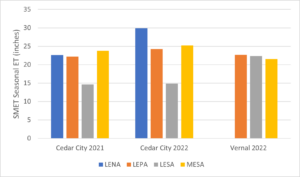
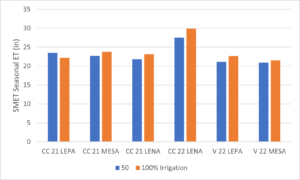
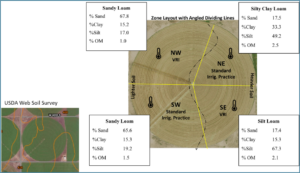
Research outcomes
- Drought-tolerant corn genetics and alfalfa cultivars with enhanced drought tolerance rarely or never improved crop yield under full or reduced irrigation rates. This indicates they may not be effective tools for conserving water.
- The low-elevation spray application sprinklers (LEPA, LESA, and LENA) often but not always maintained or improved corn and alfalfa yield with 25% less irrigation than conventional mid-elevation sprinklers. These systems have high potential to save water but benefits are site-specific and each field should be evaluated for ideal systems.
- Short-term use (3-4 years) of cover crops and no-tillage in silage corn production systems sometimes reduces corn yield. Cover crops and no-tillage separate or combined also have not yet enhanced yield under water stress conditions but may over time as soil health builds.
- Alternative forage crops such as sorghum sudangrass and teff can improve water use efficiency compared to alfalfa and silage corn.
- Preliminary results show that sector-based variable-rate irrigation systems can reduce water use without reducing crop production.
Education and Outreach
Participation summary:
The education and outreach plan is the third objective of our proposal and consists of five major activities to deliver dynamic products and trainings for producers, agricultural professionals, water managers, and related stakeholders.
- Host field days – in Phase II we planned to host field days at each of the eight locations in Idaho and Utah for Objective 1 and 2 to demonstrate treatments and present and discuss results. In addition to regularly planned field days, we anticipated hosting another four to five tours and field days for other organizations such as conservancy districts, conservation district, state agencies, politicians, and other related stakeholders. PROGRESS: We have hosted field days at the Cedar City, Logan, Vernal, and Aberdeen sites in 2022-2023. The remaining sites will have field days conducted in 2024. We have also held field days for conservancy districts, conservation districts, state agencies, and politicians. These groups were the main target audience at some events or were among the invited participants at others.
- Host a dealer, advisor, and conservation planner training – In Phase II, we planned to host another joint training event in 2023 with three groups of trainers (irrigation dealers, crop advisors, and conservation planners). This will strengthen the synergy and trust we have created during the three trainings in Phase I. It will be a two-day training held in late August and will involve research presentations, panel discussions with participants from all groups, and facilitated working groups to identify needs and opportunities to collectively advance water optimization in Idaho and Utah. PROGRESS: We hosted the combined training in the fall of 2023 at the Logan water optimization site and two other nearby farms. The training included several demonstrations, discussions, and learning activities. Nearly 100 trainers attended from Utah and Idaho, including strong participation by NRCS who were not able to participate in former trainings due to CO-VID.
- Develop multi-media outreach materials – Our multi-media outreach in Phase II will include social media education, short e-articles, and short YouTube videos through the recently established USU Extension Crops team. PROGRESS: We have posted several social media posts on all three major social media platforms (Instagram, Facebook, and X), published 4 of the proposed 5 e-articles to highlight aspects of the water optimization research in objectives 1 and 2. We will produce four videos of the proposed videos and additional e-articles and social media posts in 2024.
- Present results at producer and professional meetings – We will continue to present the research results from Objective 1 and 2 in Phase II. Presentations will be delivered in local and regional presentations to over 500 stakeholders each year in various crop schools at many locations across Idaho and Utah. The results would also be presented at various regional and national professional meetings such as the Utah Hay Symposium, Utah Soil Health Conference, California Alfalfa and Forage Symposium, Utah Water Users Conference, American Society of Agronomy, SARE conferences, and several others. PROGRESS: Results of this study have been presented in many crop schools in Idaho and Utah in 2022 and 2023, the Utah Hay Symposium in 2023, the 2022 Utah Water Users Conference, the 2022 and 2023 American Society of Agronomy Annual Meetings, and many other local, regional, and international conferences and meetings.
- Publish extension and journal articles– We anticipated in Phase II publishing at least five Extension factsheets and associated farm press and media articles, five journal articles, two thesis or dissertations, and other policy and stakeholder publications. PROGRESS: We have published six journal articles related to this research in 2022-2023. Another two are currently in review. We anticipate at least another 3-4 that will be submitted in 2024. We have published over 15 fact sheets and farm press articles in 2022-2023 to disseminate findings of this study. Tina Sullivan is defending her dissertation next week and Kamal Deep is a Master's graduate student who is co-leading this project and anticipates graduating in early 2025.
One of the major education goals of phase II of this project was to host a training for a diverse group of trainers in Utah and southern Idaho. Irrigation dealers, NRCS planners, Utah Department of Food and Agriculture Planners, Crop Advisors, and USU Extension faculty were all invited to participate in the training that we held in September of 2023 at the Logan, Utah water optimization site. Our goal was to bring together government and industry planners to foster greater conservations and collaboration towards optimizing irrigation management in Utah and Idaho. We hosted the training in coordination with an irrigation supplier (WISH-NW). We had 105 people attend the 2-day training. We provided training and demonstrations on irrigation systems (subsurface drip, pivot, and wheel-line technologies), irrigation maintenance, and irrigation management. Nearly one-third of the participants completed the meeting evaluations and it represented attendees from all major categories (Figure 1).
All respondents indicated that they were satisfied with the material presented, the quality of the training, and the quality of the speakers. A majority (90%) indicated that their knowledge of irrigation systems, maintenance, and management was ‘somewhat’ or ‘much’ better because of the training (Figure 2). The participants advised or serviced farmers on small (5-10 acres) up to millions of acres. The cumulative acres that the 33 respondents advise for totaled over 4 million. The respondents had difficulty in estimating the economic impact that the training would have on the farmers they advise but many indicated that they may be able to help farmers save about $5-25/acre.
Crop school and other Extension presentations were delivered to over 1,500 individual farmers, crop advisors, and related stakeholders in 2022 and 2023. The majority of participants regularly report knowledge gain, intention to use and apply the research, and economic improvements on their farms and ranches as a result of the education. The crop school evaluations from 2023 are still be summarized and will be included in forthcoming reports.
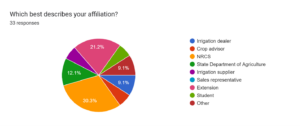
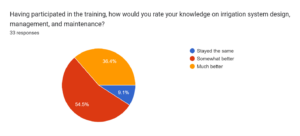
The four e-articles that were written for this project were each sent to a list-serve of about 1,800 subscribers. Nearly 200-300 or more people opened and viewed each of these articles. They were also shared on social media with about 1500 total subscribers on the three major social media platforms.
Education and Outreach Outcomes
We have learned important lessons during the second phase of this long-term project. Many lessons learned about deficit irrigation and precision irrigation were recently published as USU Extension fact sheets. The results from objective 1 on combining water optimization practices have helped guide policymakers, state agencies, water managers, and many others in Utah the last two years. The research helped inform the $200 million dollar investment in water optimization by the Utah legislature. This funding is helping to make improvements in optimization in many parts of Utah. Our research is helping to prioritize where that funding might have the greatest impact. We developed two online interactive tools to help identify the water consumption changes due to irrigation system changes, and the economics of those changes. These high demand tools have been used by many stakeholders in water optimization efforts. Recommendation: Development, expansion, and refinement of decision-aid and economic tools for water optimization are needed to help farmers, advisors, and governments effectively optimize water use in western agriculture.
We have also engaged the irrigation industry (both irrigation professionals and crop advisors) and government planners (NRCS, state department of agriculture) in a coordinated and statewide (and regional – southern Idaho) way that has never been done before. This resulted in new connections and collaborations between these important stakeholder groups who both assist growers in making irrigation decisions. Providing training and facilitating discussions to identify and meet needs, and to prioritize research efforts has helped make Extension efforts more pertinent and useful to these industries, and has and will further the use of evidence-based practices to optimize water use in Utah and in the region. Recommendation: Regular trainings and workshops with these advisors are needed to ensure that advisors are trained on the latest science, technology, and techniques.
We are continuing to identify conditions where variable-rate irrigation (VRI) might be feasible and economic. These appear to be where water requirements are highly variable, as caused by variable soils, variable yield, or variations in field conditions. Further, cooperating farmers have been eager to test sector-based VRI to learn how it might help save water and improve their production efficiency. These findings on zone (mainly phase I) and sector VRI (phase II) are being developed into a variable-rate irrigation guide that will serve Utah, Idaho, Washington, and Oregon growers in making decisions about precision irrigation implementation. This guide will also be useful to other areas in the West with overhead sprinkler irrigation systems. Recommendation: Additional development, testing, and demonstration of simple and effective approaches to sector VRI will be needed to increase adoption of this readily available, effective, and cost effective tool for water optimization.
- Water conservation with sprinkler irrigation systems for pivots
- Water conservation with irrigation management and deficit irrigation
- Water conservation with alternative crops
- Practical precision irrigation with sector control
- Use of openET to guide irrigation management
- Crop and soil management for water conservation
Use of alternative pivot irrigation sprinkler systems such as LEPA, LESA, and LENA sprinklers
Use of alternative crops that use less water
Use of sector-based variable-rate irrigation with pivots

